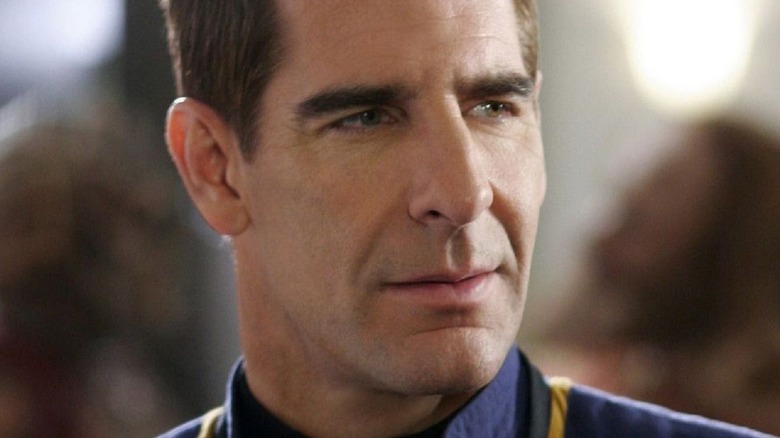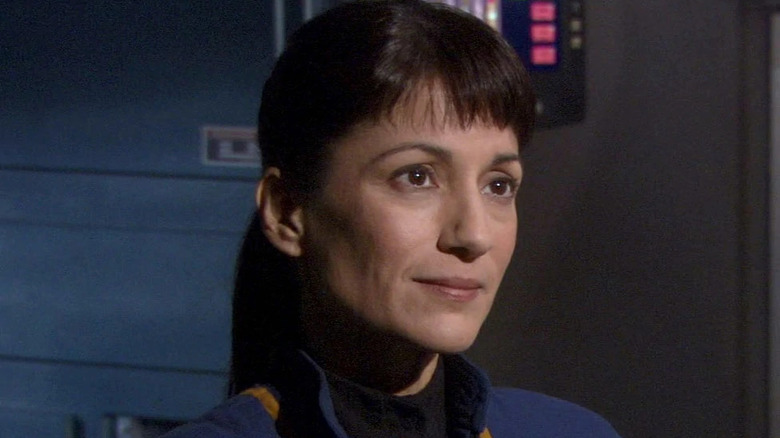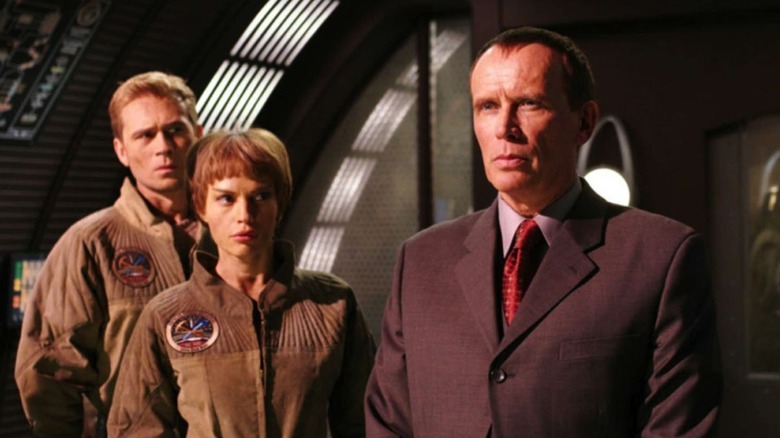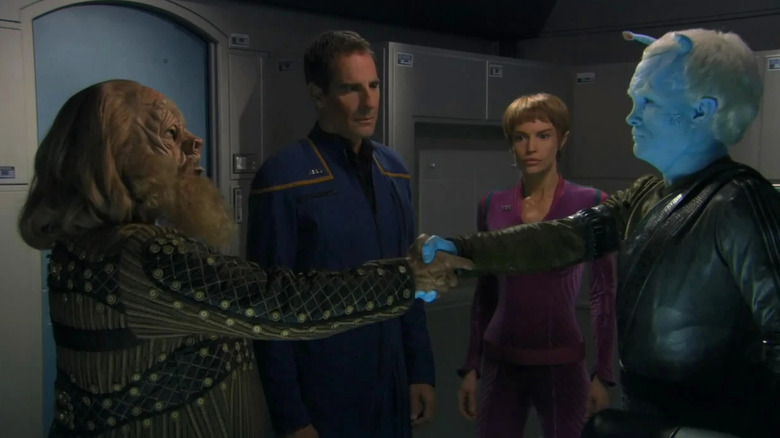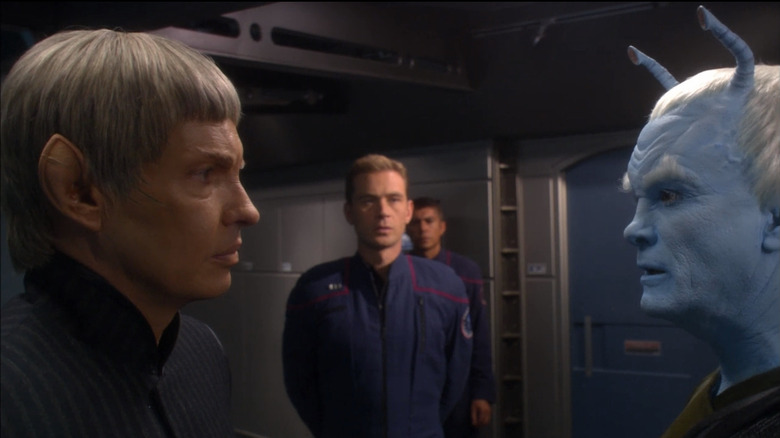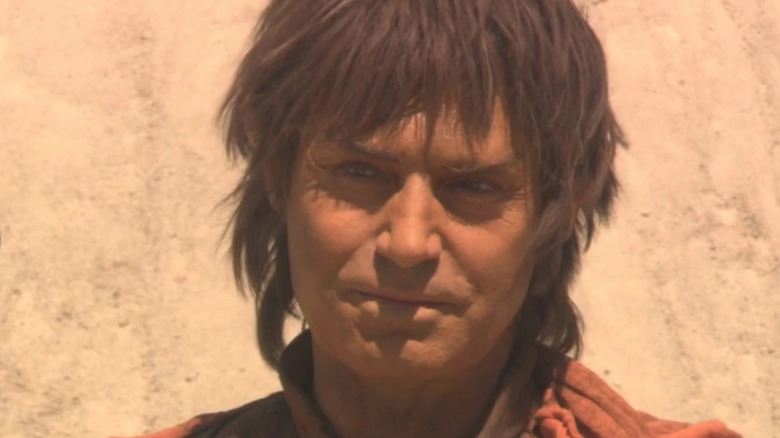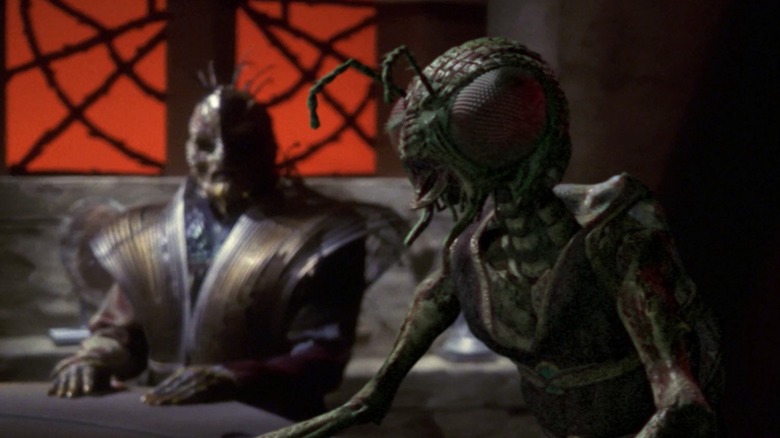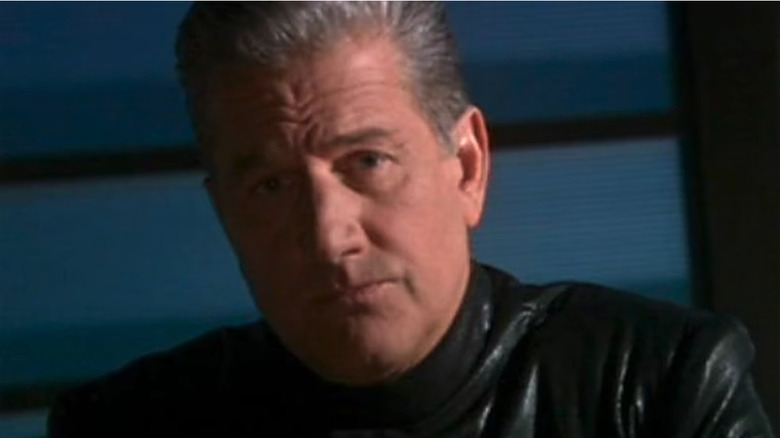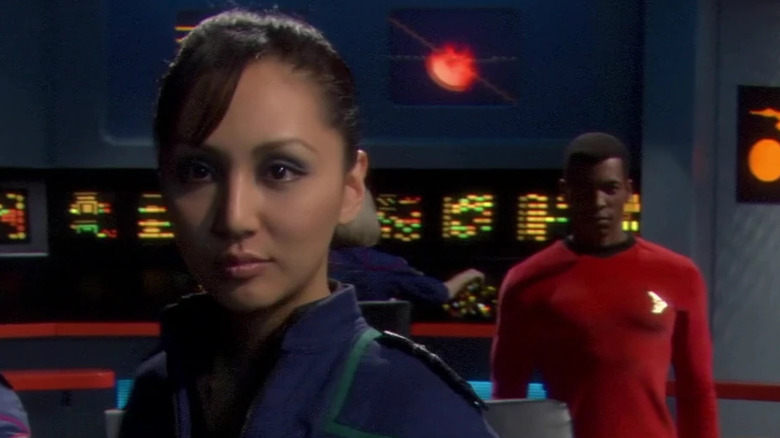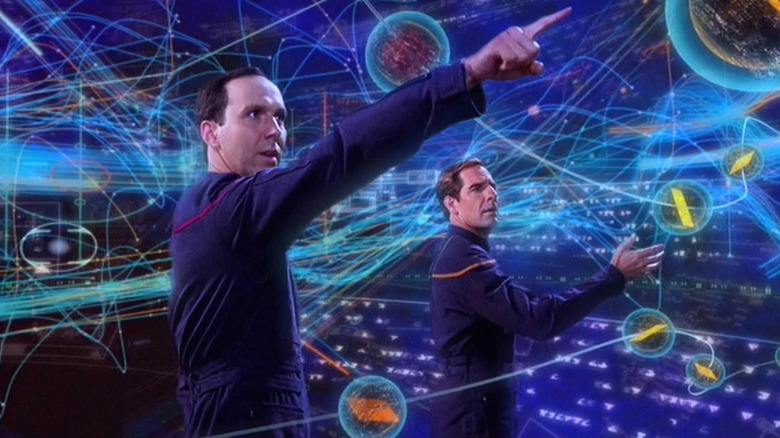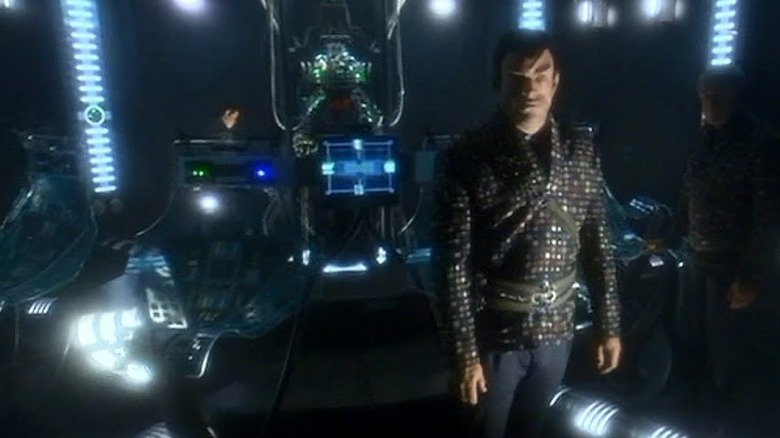Unresolved Plotlines In Star Trek: Enterprise
The fourth spinoff of the iconic science-fiction franchise, "Star Trek: Enterprise," debuted in 2001. "Quantum Leap" star Scott Bakula starred as Captain Jonathan Archer, commanding the first Warp Five ship in Starfleet's history, with a mission to seek out new life, find new civilizations, and boldly go where no one had gone before. With the series set more than a hundred years before Kirk and Spock, that mission meant even more than it had before. The NX-01 Enterprise was the first of its kind and the only Starfleet vessel capable of exploring the final frontier, meaning Archer and crew would be making first contact with a new alien race on nearly every mission.
Controversial for being a prequel, for being a bit too different than previous spinoffs, and for an infamous theme song, the series nonetheless found a passionate fan following who attempted to save it from cancelation after what would be its fourth and final season. Fourth season showrunner Manny Coto has talked candidly during interviews about how the cancelation interrupted many plans for future stories but attempts to revive the show over the years have proven unsuccessful, per IGN.
While its predecessors "The Next Generation," "Deep Space Nine," and "Voyager" all received seven robust seasons apiece, "Enterprise" ultimately ended after its fourth. Its sudden conclusion left plans for future stories on the drawing table and many plotlines unresolved. Keep reading for the biggest stories from "Star Trek: Enterprise" that fans will probably never see completed.
The evolution of Starfleet
One of the promises of "Star Trek: Enterprise" was to explore how Starfleet evolved into what it was in the original "Star Trek" series. Unfortunately, we never saw much of that on the show. When the NX-01 Enterprise launches in the premiere, "Broken Bow," it is said to be the first ship in its class and the first vessel to be able to achieve Warp Five. While the ship is set up to be the first in a new fleet of such starships, by the end of the series, Starfleet has only launched its second Warp Five ship, the NX-02 Columbia, under the captaincy of Erika Hernandez. Though we see some new developments, including the first starship phaser banks and the first use of transporters to move people (rather than cargo), Starfleet doesn't seem to evolve much during the series.
Sadly, there were plans for more that never came to fruition. During a Q&A shared by Trek Today, Manny Coto discussed plans for a proposed fifth season that would have seen further development of Starfleet on their way to the founding of the Federation. This includes an episode centered on the building of Starfleet's first starbase, and there had been hints that the military MACO soldiers would be folded into Starfleet, but the series' sudden cancelation left that hope, like many others, unfulfilled.
Oddly enough, we'd get brief glimpses of such development in the backstory of Balthazar Edison, a former MACO soldier who became a Starfleet captain, in the J.J. Abrams-produced film "Star Trek: Beyond."
Peace on Earth
One of the key components of the "Star Trek" mythos has been an optimistic view of the future, in which the people of Earth have all come together to find peace in their time. It is never said, however, how that world came to be.
Producer Rick Berman has commented that one of the original ideas for the series was to explore how Earth went from the chaotic 21st century seen in "Star Trek: First Contact" to the peaceful paradise of "The Original Series." While we do see that Earth in the 22nd century isn't yet the bastion of peace and brotherly love that we know from series set centuries later — with clashes between Earth's government, Starfleet, and Vulcan Ambassadors causing their own problems — we never really see much progress towards a utopian human alliance.
In "Terra Prime," we see a divided world where a xenophobic faction still influences Earth affairs. Though the situation proves that the xenophobes are a minority, it's hard to believe the world rejected them overnight. Given the attention the series pays to events back on Earth and the political turmoil that still exists, it's likely that further seasons of the series may have shown how the conflicts of the 22nd century gave way to the lasting peace of the 23rd and 24th centuries. However, the cancelation of "Enterprise" leaves this thread unfinished.
Founding of the Federation
Another critical aspect of "Star Trek: Enterprise" is that it takes place more than a decade before the founding of the Federation. This means that Starfleet is largely on its own while making first contact with civilizations like the Klingons, Romulans, Andorians, and others. The show chronicles how the Federation slowly comes into being, and some of that is seen in the final season. In the series opener, the Vulcans are deeply skeptical of humans. However, those attitudes soften by the end of Season 4, with Soval, who had once questioned Captain Archer's mission, now calling him a friend.
We see the path to the Federation begin in earnest during the final season three-parter that begins with "Babel One." In that episode, Archer gets the Andorians, Vulcans, and Tellarites — three races who have been at each others throats for decades — to work together to thwart a plot to destabilize the region. The episode concludes with the four races still on unfriendly terms, but it suggests that future stories with these galactic powers could be on their way to forming the famous interstellar alliance had the series continued.
Once again, though, the show's cancelation stopped that story from being told. While the show would skip ahead some years in the finale and show the signing of the first Federation charter, it felt like the series was building to a bigger arc that could have been told across further seasons as the different races went from adversaries to allies.
Andorian and Vulcan rivalry
The seventh episode of Season 1, "The Andorian Incident," makes it clear that the brief moments of hostility between the Vulcan and Andorian ambassadors in "Star Trek: The Original Series" is indicative of a once bigger rivalry. In that episode, a group of Andorians takes hostages at a Vulcan monastery and, with the help of Enterprise, reveals the site as cover for a Vulcan spy program. Over the next three seasons, tensions between the two powers continue to build. While Starfleet and Captain Archer attempt to broker peace, there are only momentary respites. Ultimately, the Andorian's mistrust of even the noblest Vulcans leads Commander Shran to kidnap and torture Vulcan Ambassador Soval.
In the final season, the Vulcans and Andorians manage to work together against a Romulan plot, but the feud between the two races is still a story left unfinished. Producer Manny Coto's plans for a fifth season were said to include an increased role for the Andorian Commander Shran, the high-ranking Andorian played by fan-favorite Jeffrey Combs. In a proposed story, Enterprise would have undergone a refit and reshuffling of personnel, with Shran possibly even joining the bridge crew on the Enterprise, perhaps as an Ambassador, exchange officer, or advisor. This would have likely provided many opportunities for stories to delve deeper into the conflict between the Andorians and the Vulcans, perhaps even evolving their relationship as Shran and T'Pol serve side by side.
The Vulcan Reformation
A surprising development at the start of the first season of "Star Trek: Enterprise" sees the Vulcans portrayed very differently than fans had come to expect. Particularly, the Vulcan High Command is far more antagonistic than we might have thought. Audiences see the often stoic race in a new light, as more volatile, almost emotionally belligerent, towards both their rival Andorians and Starfleet.
While this definitely ruffled some feathers among diehard Trekkies, few could deny that it gave the emotionless Vulcans a lot more depth and character than we'd ever seen before. Over time, however, it became clear that this wasn't just a simple retcon, but there was a significant reason for their different characterization — the Vulcan Reformation.
According to a key storyline in the show's fourth season, it wasn't until this era that the Vulcan's truly found their way to logic, at least not as we had seen it on "The Original Series" and beyond. A new, quasi-religious figure named Syrran, who carries the katra — or soul — of the Vulcan messiah Surak, helps lead the Vulcan people to enlightenment in a three-part story that culminates in the episode "Kir'Shara." However, the Vulcan people would not change overnight, and thanks to the early ending of the series, the story of their people's journey to a new age was never resolved, another tale left sadly incomplete.
The Xindi
The Xindi War story arc spread across the entirety of the third season of "Star Trek: Enterprise" was just as controversial and polarizing as it has been popular with fans in the years since. Many have called it a turning point in the series, while others felt it was a moment that took the series too far, as it shed the optimism the show was known for. However fans think of it, it's always felt like a story left unresolved. Not because the narrative was incomplete, per se, but because once the season ended, the Xindi are never seen again, and the ramifications of the universe-altering storyline seem to vanish into thin air.
The Xindi are an alliance of five races — not all of whom were entirely friendly with one another — who seek to wipe out humankind, thanks to intelligence from the future that informs them that humans will be their ultimate downfall. Eventually, Archer and Enterprise, with help from Andorians and Vulcans, manage to stop the Xindi from destroying Earth, but the story is left with a Xindi Empire fractured and in chaos. What becomes of them? What happens to the powerful planet-killing machines they develop using technology from the mysterious race of so-called "sphere builders"?
These and other lingering questions seem far too important to the future of the franchise — considering no one has ever even mentioned the Xindi into the 24th Century — to be left entirely unanswered.
Section 31
We first see appearances of the rogue Starfleet intelligence agency Section 31 on "Star Trek: Deep Space Nine," but that also proves to be an unresolved storyline. Now, on "Enterprise," set some 250 years before, we think we might finally get some answers. We get a few, including the origin of the organization's name — they were founded under Section 31 of the original Starfleet charter — and we even discover that Enterprise security officer Malcolm Reed is one of their earliest recruits. But beyond that, we learn little, and a storyline that feels like a promising start is never realized.
Though we do see it pay off, in a way, with the two-parter "Terra Prime" and "Demons," when Section 31's intelligence helps to thwart a terrorist attack. For a while, it feels like the subplot of Malcolm in Section 31 might lead somewhere more compelling. Beyond that, Section 31's role in the Klingon virus that erases the race's famous forehead ridges — turning them into the more human-like Klingons we meet on "Star Trek: The Original Series" — is a fascinating insight.
However, these developments end up simply teasing a bigger exploration of the clandestine Starfleet spy group that we never see. Had the series continued past its fourth season, Malcolm could have been a character we may have seen much more of, especially as Section 31 came to the attention of Captain Archer. In his final appearance, it's even teased that Malcolm might one day become a greater part of the organization, but we never find out what Section 31 had planned for him.
The Mirror Universe
Producer Manny Coto became showrunner of "Star Trek: Enterprise" for its fourth season, and one of his hopes was to tell stories that tied back to "Star Trek: The Original Series." One such storyline was the two-part episode "In a Mirror, Darkly." Set entirely in an alternate reality, its story converges events from the 1968 "Star Trek" episode "The Tholian Web," showing the final destination of a Federation Starship that had disappeared. Discovering that the 23rd Century starship has traveled back in time into a parallel universe, the mirror Captain Archer sets out to use it to help the Terran Empire in the 22nd Century.
Archer enacts a bold plan to seize control of the Empire using the futuristic starship but is thwarted by Hoshi Sato, who eliminates Archer and takes command. The episode ends with Hoshi announcing herself as Empress, while the fate of the mirror version of Archer is never revealed, cleverly setting up a possible return. Manny Coto has since said that if "Enterprise" had gotten another season, we'd have seen more stories set within the Mirror Universe as a "series within a series," but for now, it remains another casualty of the show's premature cancelation. The Mirror Universe was seen again in "Star Trek: Discovery," and the events in "Enterprise" are referenced, as noted by Inverse.
Who knows, with a mirror version of Phillipa Georgiou said to be receiving her own series, it's still possible we'll learn what happens after "In a Mirror, Darkly."
The Temporal Cold War
The series was first launched as "Enterprise," eschewing the "Star Trek" name entirely. It also tried to shed the image as an episodic series as long-form storytelling became more popular on shows like "The West Wing" and "The Sopranos." To that end, at the behest of the studio, the producers created the Temporal Cold War as an ongoing story arc for the series.
Introduced in the series premiere "Broken Bow," viewers meet a shadowy figure that speaks to the villainous Suliban through a time portal. This being communicates to the Suliban from the future and attempts to alter past events in his favor. On the opposite side is a mysterious man named Daniels, who claims to be working on the opposing side of the conflict on behalf of the future Federation. The plotline was ill-conceived from the start, with seemingly no concrete plan from producers on evolving the story. Over the first three seasons, it ends up a mess of different ideas before being abandoned by the beginning of the fourth season with the conclusion of the war with the Xindi.
Audiences never really responded to the storyline, and when the series closed out its run in 2005, there were no firm answers of who this future representative was. Showrunner Manny Coto had plans to resolve it in a possible fifth season, but that never came to pass. However, the so-called Temporal Wars have been referenced by the man called Kovich in the 32nd Century on "Star Trek: Discovery," so there's a chance we may get some resolution.
The Romulan War
One ongoing plot thread in the final season is the growing tension between Earth and the Romulan Empire. According to "Star Trek" lore, a war with the Romulans is one of Earth's first major interstellar conflicts, and it rages during the early days of human space travel. Over the course of "Enterprise," it becomes clear that the so-called "Romulan War" is in Archer's near future, as episodes like "Minefield" in the series' second season tease an Empire ready to declare Earth an enemy. The fourth season three-parter that begins with "Babel One" sees the Romulans manipulating events to spark a war between Starfleet, the Vulcans, the Tellarites, and the Andorians.
It is all leading towards all-out war, and that was confirmed by producer and showrunner Manny Coto during VegasCon09, when he mentions that one of the major arcs for a proposed fifth season would have been the first "whispers of the Romulan War."
Seeing as many previous "Star Trek" series had run seven seasons, it's not hard to imagine a multi-season story culminating with a victory over the Romulans. There is even a storyline involving a deep cover Romulan agent embedding within the Vulcan High Command, which could have drawn the Vulcans into the conflict. As it stands, all we get is one long tease, an obvious cliffhanger, and no resolution, leaving fans in the dark as to how a war with the Romulans played out in one of "Star Trek" history's most famous unseen conflicts.
